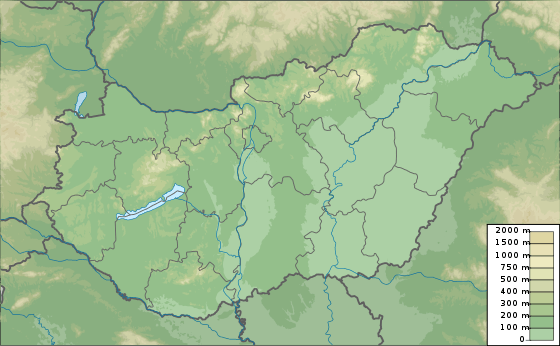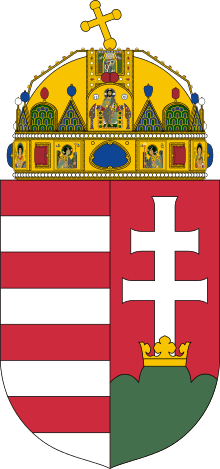Hungarian Air Force
| Hungarian Air Force | |
|---|---|
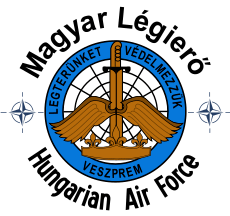 Hungarian Air Force emblem | |
| Founded | 1918 |
| Country |
|
| Allegiance | Hungarian Defence Forces |
| Type | Air force |
| Role | Aerial warfare |
| Size | 3,500 active duty personnel |
| Garrison/HQ | Budapest |
| Colors | red, white, green |
| Anniversaries | 15 August. |
| Commanders | |
| Current commander | Brigadier General Albert Sáfár |
| Insignia | |
| Roundel |
 |
| Low visibility roundel |
 |
| Aircraft flown | |
| Fighter | JAS 39 Gripen |
| Trainer | Zlin 242 |
| Transport | Airbus A319, Antonov An-26, Mil Mi-8, Mil Mi-17, |
The Hungarian Air Force (Hungarian: Magyar Légierő) is the air force branch of the Hungarian Defence Forces.[1]
The task of the current Hungarian Air Force is primarily defensive purposes. The flying units of the air force are organised into a single command; under the Air Command and Control Centre[2]
Structure
The following units are part of the Hungarian Air Force, but like all other operational units of the Hungarian Defense Forces they fall under operational control of the Hungarian Defense Forces Combat Command in Székesfehérvár
- Hungarian Defense Forces Combat Command, in Székesfehérvár
- Air Operations Centre, in Veszprém, reports to NATO's Integrated Air Defense System CAOC Uedem in Germany
- Air Operations Centre
- Air Traffic Control Centre
- Reserve and Training Air Traffic Control Centre, at Kecskemét Air Base
- Military Air Traffic Management Centre
- Meteorological Centre
- Simulation and Exercise Centre
- 12th Air Defense Missile Regiment "Arrabona", in Győr
- 54th Radar Regiment "Veszprém", in Veszprém
- Command Company
- 1st Radar Data Centre, in Békéscsaba, with RAT-31DL
- 2nd Radar Data Centre, in Medina, with RAT-31DL
- 3rd Radar Data Centre, in Bánkút, with RAT-31DL
- 11th Radar Company, in Kup
- 12th Radar Company, in Juta
- 21st Radar Company, in Debrecen
- 22nd Radar Company, in Békéscsaba
- Gap Filling Radar Company, in Medina
- 59th Air Base "Dezső Szentgyörgyi", at Kecskemét Air Base
- Base Operations Center
- Tactical Fighter Squadron "Puma", with 13x JAS-39C/D Gripen
- Airlift Squadron "Teve", with 1x An-26, 2x Airbus A319
- Operations Support Battalion
- Maintenance Battalion
- Logistic Battalion
- 86th Helicopter Base "Szolnok", at Szolnok Air Base
- Base Operations Center
- Transport Helicopter Squadron "Ernő Rubik", with 5x Mi-8, 5x Mi-17
- Mixed Training Squadron, with 2x AS350, 2x Z-242, 2x Z-143
- Operations Support Battalion
- Maintenance Battalion
- Logistic Battalion
- Pápa Air Base
- Base Operations Center
- Heavy Airlift Wing (NATO Strategic Airlift Capability), with 3x C-17 Globemaster III
- Operations Support Battalion
- Logistic Battalion
- Information Protection Group
- Air Operations Centre, in Veszprém, reports to NATO's Integrated Air Defense System CAOC Uedem in Germany
The Hungarian Air Force Aircraft Repair Facility at Kecskemét Air Base falls under the Hungarian Defense Forces Logistics Center in Budapest.
59. Air Base "Dezső Szentgyörgyi"
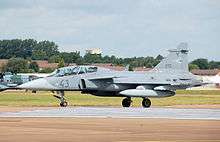
The 59th Air Base is the fixed-winged part of the Air Force. The 59th consists of one tactical fighter squadron and one airlift squadron.
There Fighter Squadron is nicknamed "Puma" and operates JAS-39C/D Gripen fighters.[3] The Hungarian Air Force is leasing 14 JAS 39 Gripens, two of which are two-seaters, for 12 years beginning in 2006 (later extended until 2026). By December 2007 all the 14 jets had been delivered.[4] On 19 May 2015 one two-seater Saab JAS39D Gripen crashed at the end of the runway at the Čáslav AFB. The pilots ejected safely, but the aircraft, nr. 42 with callsign PUMA66 was written off, damaged beyond repair.[5] After the lease period expires, Hungary will own the remaining Gripens.
The Airlift Squadron operates one An-26 and two Airbus A319 transport aircraft. The An-26 is due to be replaced by new transport planes after 2017.
86th Helicopter Base "Szolnok"
The 86th Base is the home of the air force's helicopters. The 86th consists of one transport and one attack helicopter battalion.
The transport helicopter battalion of the 86th Wing operates Mi-8T and Mi-17N helicopters.
The attack helicopter battalion was recently disbanded and a new unit, in combination with the transport helicopters, will be formed. In April 2017, the defense minister stated that he planned to put the unit's Mi-24D/V/P attack helicopters back into service.
The Training Squadron operates Z-242L trainers and AS-350B helicopters.
12th Air Defense Missile Regiment
The 12th Air Defense Missile Regiment is in charge of providing air defense to Hungary and fields:
- 2K12 Kub mobile Surface-to-air missile (SAM) systems. (To be replaced entirely with a modern system)
- Mistral lightweight SAM systems mounted on Unimog all-terrain vehicles
- 36D6 Tin Shield modernized, all-altitude surveillance radars, with domestically developed digital electronics suite.
During the Cold War period communist Hungary had numerous SA-2, SA-3, SA-4 and SA-5 batteries and a large number of radar installations, mostly tasked with defending the Danube line against NATO air strikes.
Pápa AFB
Pápa Air Force Base was established as a military organization on 1 July 2001 as a part of Hungary's commitments to NATO's Infrastructural Development Program, and it is the legal successor of the HDF 47th Pápa Tactical Fighter Regiment.
Aircraft
Current inventory
.jpg)
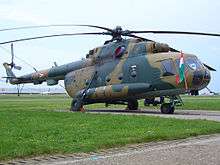
| Aircraft | Origin | Type | Variant | In service | Notes | |
|---|---|---|---|---|---|---|
| Combat aircraft | ||||||
| JAS 39 Gripen | Sweden | multirole | JAS 39C | 12[6] | ||
| Transport | ||||||
| Airbus A319 | Germany | VIP transport | 2[7] | |||
| Antonov An-26 | Ukraine | transport | 1[6] | |||
| Dassault Falcon 7X | France | transport | 1[8] | |||
| Helicopter | ||||||
| Mil Mi-17 | Russia | utility | Mi-8/17 | 13[6] | ||
| Mil Mi-24 | Russia | attack | Mi-24 V/P | 8[9] | ||
| Airbus H145M | France / Germany | utility | 20 on order[10] | |||
| Eurocopter AS350 | France | liaison | 2[6] | |||
| Trainer aircraft | ||||||
| Zlín Z 42 | Czech Republic | basic trainer | 242 | 2[6] | ||
| Zlín Z 43 | Czech Republic | basic trainer | 143 | 2[11] | ||
| JAS 39 Gripen | Sweden | conversion trainer | JAS 39D | 2[6] | ||
Three C-17 Globemaster III’s are stationed at Pápa Air Base in Hungary to support NATO’s Strategic Airlift Capability operations.[12]
Aircraft markings
The Hungarian aircraft marking is a set of aligned triangles which points toward the front of the aircraft. They are the same colour as the Hungarian flag, red, white, and green. The innermost triangle is green, follow by white, and then red. It is displayed on the side of helicopters and in the standard four wing positions on aircraft. It was used by the Royal Hungarian Air Force until 1942, and then reinstated after the Second World War. The new Gripen fighters will wear a NATO standard compliant grey-on-grey (low-visibility) version of the Hungarian triangle insignia.
History
1918 to Pre–World War II
Following the dissolution of the Austro-Hungarian Monarchy in 1918, a small air arm was established operating surviving aircraft from Hungarian factories and training schools. This air arm became the Hungarian Red Air Force under the short lived Hungarian Soviet Republic, but was disbanded upon its downfall.[13]
World War II
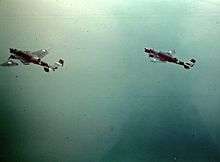
Under the Treaty of Trianon (1920), Hungary was forbidden from owning military aircraft. However, a secret air arm was gradually established under the cover of civilian flying clubs. During 1938, as a result of the Bled agreement, the existence of the Royal Hungarian Air Force (Hungarian: Magyar Királyi Honvéd Légierő (MKHL)), was made known. The army's aviation service was reorganized and expanded.
Late 1938 the army aviation was once again reorganized. Admiral Horthy, the head of state, ordered that the army aviation should become an independent service effective 9 January 1939. Colonel Ferenc Feketehalmi Czeydner became the Air Section Chief in the Honvéd Ministry; Major General Waldemar Kenese became Inspector of the Air Force; Colonel Ferenc Szentnémedy became Chief-of-Staff, and Colonel László Háry was appointed head of the Magyar Királyi Honvéd Légierő (MKHL).
It subsequently participated in clashes with the newly established Slovak Republic and in the border confrontation with the Kingdom of Romania. In April 1941, operations were conducted in support of the German invasion of Yugoslavia and, on 27 June 1941, Hungary declared war on the Soviet Union.
In 1940, the decision was made to unite the Air Force, the anti-aircraft forces, and the civilian air defense organizations under one central headquarters. Colonel László Háry was retired 24 December 1940, and on 1 March 1941 the new organization was constituted. General András Littay became Air Sub-Department Chief, and Colonel Géza Vörös was appointed Head of the Air General Staff. On 1 June 1941, the Air Defense Corps was established, and Lieutenant General Béla Rákosi[14] became Commander of Army Aviation. In effect the Air Force had once again become part of the Army.
In the summer of 1942, an air brigade was attached to the Luftwaffe's VIII. Fliegerkorps on the Eastern Front. Beginning March 1944, Allied bomber raids began on Hungary and progressively increased in intensity. Late in 1944 all efforts were redirected towards countering the advancing Red Army, but to no avail. All fighting in Hungary ended on 16 April 1945.[13]
Post–World War II to Present
A small air arm was organised along Soviet lines during 1947. Following the communist takeover, Russian military aid was stepped up and a major expansion program initiated. When Soviet forces invaded to suppress the 1956 Hungarian Revolution, sections of the Hungarian Air Force attacked Soviet forces and resisted Russian attempts to occupy their bases. The resistance was short-lived and the entire Hungarian air force was demobilized soon after. A reconstituted air arm was reformed in the following year, but initially only as an internal security force. Gradually, starting in 1959 as Hungary became stable, the air force was expanded again, but it remained an integral part of the army and was essentially a defensive force. The Soviets kept Mikoyan-Gurevich MiG-29s based at Tokol until 1991 to defend Hungarian airspace.
In mid-1993, three batches of MiG-29s were delivered from Russia. They were based at Kecskemet. In 1994, a German gift of 20 MIL 24D/V's and 20 L-39's were donated. In 1997, Hungary undertook its first flying training course since 1956. The cost of the course was too high and was halted after the completion of only one course. Also in 1997 the MIG-23s were withdrawn from service as the Su-22s were retired after an overhaul. During the 1990s all combat aircraft were fitted with new Identification Friend or Foe (IFF) systems to enable operations in Western airspace. In April 2002, Hungary joined the NATO Flying Training in Canada (NFTC) pilot training program.[13]
Museums
The 86th "Szolnok" Helikopterezred maintains the Museum of Hungarian Aviation, which has the largest collection of "retired" military aircraft in Hungary. Some aircraft are also displayed at the Kecel Military History Park.
Insignias
.svg.png) First roundel of the Hungarian Red Air Force in 1919.
First roundel of the Hungarian Red Air Force in 1919..svg.png) Second & Third roundel of the Hungarian Red Air Force in 1919.
Second & Third roundel of the Hungarian Red Air Force in 1919..svg.png) Roundel of the Royal Hungarian Air Force between 1938 – 1941.
Roundel of the Royal Hungarian Air Force between 1938 – 1941..svg.png) Roundel of the Royal Hungarian Air Force between 1942 – 1945.
Roundel of the Royal Hungarian Air Force between 1942 – 1945..svg.png) Roundel of the Air Force of the Hungarian People's Army between 1948 – 1949.
Roundel of the Air Force of the Hungarian People's Army between 1948 – 1949..svg.png) Roundel of the Air Force of the Hungarian People's Army between 1949 – 1951.
Roundel of the Air Force of the Hungarian People's Army between 1949 – 1951..svg.png) Roundel of the Air Force of the Hungarian People's Army between 1951 – 1990.
Roundel of the Air Force of the Hungarian People's Army between 1951 – 1990..svg.png) Roundel of the Hungarian Air Force between 1990 – 1991.
Roundel of the Hungarian Air Force between 1990 – 1991. Roundel of the Hungarian Air Force from 1991.
Roundel of the Hungarian Air Force from 1991. Roundel of the Hungarian Air Force, low visibility version.
Roundel of the Hungarian Air Force, low visibility version.
References
- ↑ "The Military Balance: Vol 117, No 1". Tandfonline.com.
- ↑ "Scramble". Scramblemagazine.nl. Retrieved 23 December 2014.
- ↑ "Hungarian Gripens police Slovenia". AIRheads↑FLY. Retrieved 23 December 2014.
- ↑ "Hungarian Gripens get CAS role". AIRheads↑FLY. Retrieved 23 December 2014.
- ↑ Ranter, Harro. "Saab JAS 39D Gripen 42 Accident, 19 May 2015". Aviation-safety.net.
- 1 2 3 4 5 6 "World Air Forces 2018". Flightglobal Insight. 2018. Retrieved 1 January 2018.
- ↑ "The Hungarian Defence Forces purchase two new Airbuses". 21 December 2017.
- ↑ "Business jettel fokozta légiszállító képességét a honvédség". 5 August 2018.
- ↑ Draga lett a honvedsegi helikopterek felujitasa
- ↑ "Hungary orders 20 H145Ms."
- ↑ "Ujabb ket Zlin repulogep Szolnokon". honvedelem.hu. 22 March 2018. Retrieved 6 October 2018.
- ↑ "Strategic Airlift Capability (SAC)". Nato.int. Retrieved 8 April 2017.
- 1 2 3 "Archived copy". Archived from the original on 11 February 2006. Retrieved 17 February 2006.
- ↑ "Biography of Lieutenant-General Béla Rákosi (1889 – 1968), Hungary". Generals.dk.
Bibliography
- Dorschener, Jim. "Hungary's Fleet Revolution". Air International, Vol. 86, No. 2. February 2014. pp. 72–75. ISSN 0306-5634.
Further reading
- World Air Power Journal No.3 p. 150
- World Air Power Journal No.14 p. 148
- Air Forces Monthly June 1997
External links
- "Insignia of the Hungarian AF: from the WWI until the present". Home.mit.bme.hu. Retrieved 23 April 2018.
- "Hungary - Air Force". Flagspot.net. Retrieved 23 April 2018.
- "Légtér". Hunaf.hu. Retrieved 23 April 2018.
- "Hungarian Air Arms". Web.archive.org. 11 February 2006. Archived from the original on 11 February 2006. Retrieved 23 April 2018.
- "Honvédelem.hu". Web.archive.org. 24 September 2015. Archived from the original on 24 September 2015. Retrieved 23 April 2018.
- "Avia-info.hu". Horac.fw.hu. Retrieved 23 April 2018.
